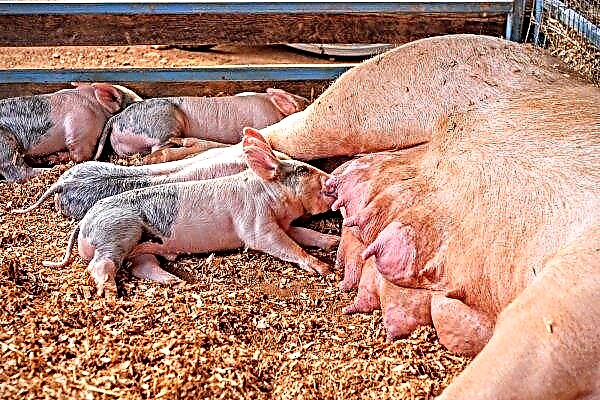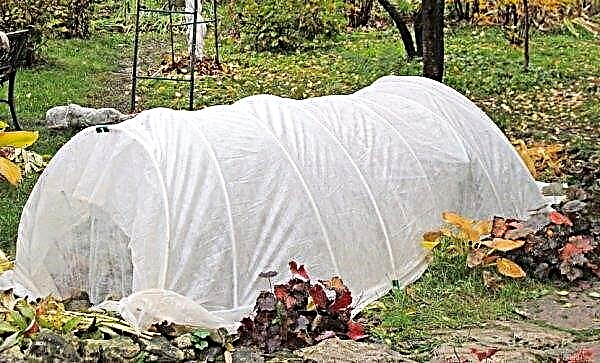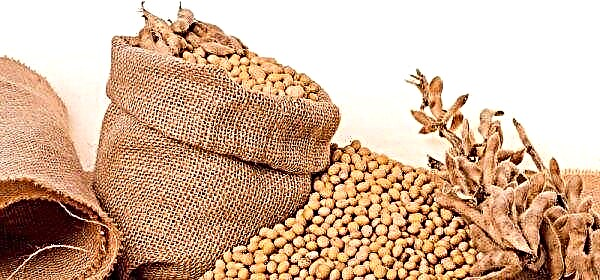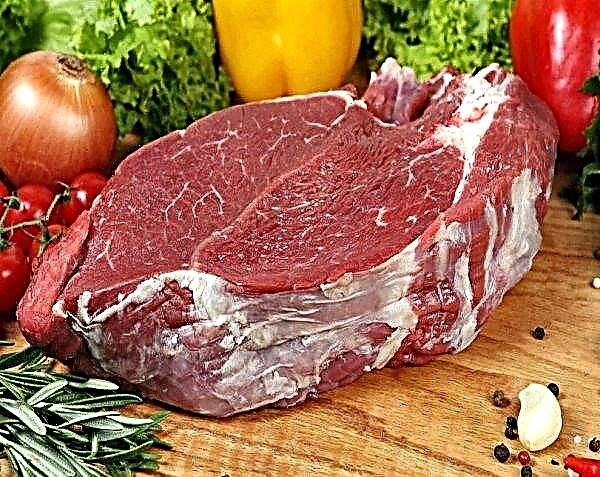In today's market there are many different feeders for poultry. Bunker is no exception. They are commercially available in a wide range. However, with some effort and ingenuity, an automatic feeder can be done with your own hands literally from improvised materials. What materials and tools will be needed for the job, how to make and install it, read in this review. Here are some drawings.
What is a bunker system for feeding chickens
Bird feeders can be classified according to several criteria. For example, by type of fastening (hanging, wall, floor); according to the type of food for which they are suitable (dry food or wet), as well as the method of food supply (tray, grooved or automatic).
The last variety of feeders is considered the most convenient when using bulk feeds and is therefore very widely used by poultry farmers. Such devices are called bunker devices.
The very idea of a bunker feeder is that only a part of the feed contained in it is directly accessible to the bird, while the main supply of dry mix is located in a closed container. When the tray is emptied to a certain critical volume, the next part of the feed is fed from a special hopper.
And what is fundamentally important, this happens automatically, without human intervention. So, the simplest hopper feeder consists of two main parts - a compartment for feed reserves and an open area (tray), from which birds can gnaw grain mixture without hindrance. These containers can be connected with a special groove.
So, the simplest hopper feeder consists of two main parts - a compartment for feed reserves and an open area (tray), from which birds can gnaw grain mixture without hindrance. These containers can be connected with a special groove.
In other designs, the feed from the hopper enters the open tray “by gravity”, subsiding as the part of the grain that is accessible to the bird sags.
More sophisticated automatic feeders include the creation of several silos for different types of dry food: grain mix, fine gravel, premixes and mineral fertilizing.
Did you know? The largest poultry farm in Russia is located in the Tyumen region. The company contains about four million chickens. Over a billion eggs of thirty different species are sold annually.
Devices can vary in terms of total volume, number of feed pads, type of fencing (the presence of a single tray, restriction boards, grilles).
Benefits
The advantages of automatic devices over conventional trays and gutters (not to mention feeding grain to a bird by spreading it on the floor) are obvious.
- The advantages of such a feed system are as follows:
- ensures compliance with sanitary standards in the house, eliminates the turning of the feeder and the scattering of its contents;
- protects the main part of the feed from contamination and trampling by the bird, as a result, the risk of developing infectious diseases (coccidiosis, histomonosis, trichomoniasis) is reduced, and the cost of purchasing feed is also reduced;
- requires minimal time spent on measuring and falling asleep dry mixes (the procedure is performed no more than once a day instead of three or more times, the volumes of some devices are designed for several days), which means it can significantly reduce the number of staff in the house;
- gives the bird uninterrupted access to clean and fresh food, which is especially important when rearing young animals that require more frequent feeding, as well as broilers that eat almost continuously;
- due to the constant availability of feed, the accumulation of birds around the feeder is eliminated, which saves free space near the tray, which should be for each individual, and also eliminates mutual injury to the inhabitants of the house;
- the device is convenient and easy to use;
- allows you to quickly and effortlessly clean and disinfect all components of the device;
- It provides many modifications, so it can be used for keeping any poultry, regardless of species, size and age.
Did you know? The most gluttonous bird in the world eats as much feed per day as it weighs. two thirds of her body part. She lives in the Antilles. It is smaller in size than a sparrow and is called Todi. The chicks of this baby during the day eat about a hundred and forty times.
Disadvantages
The disadvantages of the automatic bird feeding system are few, but they are.
- So, the disadvantages of the design include:
- high cost of some models;
- the inability to use wet feed;
- lack of control over the amount of food eaten by the bird and its excessive availability, which can lead to obesity of the livestock (for this reason, many hosts prefer to feed from ordinary trays or gutters);
- risk of damage to the feed stored in the bunker (if the house is too wet, the grain may become damp and even mold, which will adversely affect the health of the bird);
- increased risk of rodents in the house (pests are attracted by the constant availability of grain that chickens do not peck during one feeding, as happens with traditional feeders).

Chicken hopper requirements
To summarize the above, we can formulate the basic requirements for an automatic feeder, which must be taken into account both when purchasing it and when trying to make a structure yourself.
These requirements are as follows:
- The feed storage tank must be large enough to provide at least a daily portion of the feed needed for a given number of individuals in the house.
- The feed intake in the tray should be free enough so that the bird does not have to expend effort on extracting the mixture from the hopper (otherwise the feathered population will remain hungry or, “fighting” with the device, will quickly damage it).
- An open area for food should be equipped so that the birds do not have the opportunity to climb into it completely, and also provide for sufficiently high sides to prevent spillage of food.
- The device must be installed stable enough so that it cannot be knocked over (but it should not be too heavy either).
- Mobility of the feeder (the ability to easily remove and disassemble).
- The material from which it is made must be well cleaned.
- Volumes, number of tanks, installation location, method of attachment and other structural details should be thought out in advance, taking into account the individual needs of the farmer: type of bird, its size, purpose (meat breeds require more abundant feeding), herd sizes (available and planned in the future).
Important! The general principle for determining the size of the tray is as follows: 10 cm in length per adult chicken, 5 cm — on chicken and 2.5 cm — on an individual of any age if the tray is round. The volume of the bunker is determined in such a way that it holds at least 200 g of dry mix for each adult chicken, which on average is its daily diet.
The specified requirements for the size of the feeder must be maintained, in general, for the house. If the size of the herd is such that one design is too cumbersome, it makes sense to purchase or make several smaller feeders.
DIY bunker chicken feeders
In specialized stores there are automatic feeders for every taste, and the simplest models at a price are quite affordable.
For example, the cost of a rather primitive device with a hopper volume of five liters and a tray diameter of 30 cm starts from two US dollars, a galvanized steel structure with a volume of five times more will cost at least ten dollars.
However, even these relatively small costs can be avoided by making a container with automated feed supply with your own hands, and for this you do not need to purchase raw materials (you can use what is at hand).
Important! Saw files on wood should not be used when working with the pipe, since large teeth severely deform the plastic, which can cause the pipe to crack.
As an example, the drawings and detailed instructions for the manufacture of two types of hopper feeders - from scraps of sewer pipe and from the remnants of plywood - are presented below.
From the sewer pipe
To make such a half-open hopper feeder, the following materials and tools will be needed:
- polyvinyl chloride pipe with a diameter of 110 mm (you can use a different diameter, it all depends on the type and size of the bird) - 1.5 m;
- elbow for pipe - 1 pc.;
- plug for pipe - 1 pc.;
- latches for fastening the pipe (it is better to use wide ones) - 2 pieces;
- plastic container as a hopper (you can use a bottle for drinking water with a volume of 10 liters);
- jigsaw;
- metal saws for a jigsaw (with small teeth);
- screwdriver;
- drill bits for metal with a diameter of 8 mm;
- level (it is convenient to use for marking, since it easily fits on the surface of the pipe);
- crosshead screwdriver;
- felt-tip pen or soft pencil for marking;
- a wooden block of rectangular shape, approximately 8 cm long and 5 cm wide as a pattern;
- file for trimming edges;
- wide-head screws for installing the finished design.
Sewer feeder and drinker: video
The manufacturing technology of the feeder is as follows:
- Install a bend on one end of the pipe, and close the other with a plug.
- Lay the pipe on a horizontal surface and secure with any support.
- Put the level on the surface of the pipe and set it symmetrically.
- Using a felt-tip pen, mark two parallel horizontal lines on the pipe surface, circling the level on both sides.
- 1 cm away from the edge of the pipe protected by a plug, mark with a bar for future holes: the size of the hole corresponds to the length of the bar, the distance between the holes ("islands") - its width.
- Mark future holes along the entire length of the marking with a cross so that you do not accidentally make a mistake when cutting.
- Using a Phillips screwdriver (or other sharp object), make two small recesses in the upper and lower corners diagonally in each rectangle marked for the future hole.
- Armed with a screwdriver, make holes at the designated points.
- Saw holes with a jigsaw according to the finished marking, starting work from a corner hole.
- Gently file the edges of the holes so that the bird does not hurt by putting its head in the feeder. The fixture is ready.



Important! The suggested hole spacing should not be violated. If it is less than the specified length, the "island" will begin to bend, and too long holes will lead to the folding of the entire pipe. The holes will be narrower — the bird can get hurt, and if you place them less often, fewer individuals can come to the feeder at the same time. Correction can be made only for the thickness of the pipe: the larger it is, the smaller the distance can be left between the slots.
Installation of the feeder is carried out under a slight slope so that the grain can freely sprinkle along its entire length. The structure is screwed to the wall of the house using standard fasteners for sewer pipes. The side of the pipe ending with the elbow is placed closer to the entrance, and attachments for the hopper are made above it.
It remains only to pour grain into a plastic container and insert it into the knee with its neck down.
From plywood
For work you will need the following materials and tools:
- 6 mm thick plywood sheet (trimmings of suitable sizes can be used);
- wooden blocks;
- jigsaw;
- wood files;
- drill;
- screwdriver;
- self-tapping screws;
- marker for marking;
- tape measure or any other measuring tool;
- sandpaper for stripping;
- hinges for the cover.
Plywood hopper feeder: video
The manufacturing technology of such a feeder is not more complicated than the one described above:
- On a plywood sheet, mark out all the details of the structure, marking each of them with a marker (right, left walls, bottom).
- Using a jigsaw, cut out marked parts.
- Attach a block to the long side of the bottom with five screws, placing them with a tape measure at the same distance from each other.
- Attach the rear wall of the feeder to the resulting rail.
- Based on the drawing, attach a block to the upper side of the rear wall.
- From the end of the bar to the front side of the bottom, screw on the diagonal diagonal angle bar, along which the grain will be poured from the hopper into the tray.
- Secure the side walls of the feeder.
- Lastly, the front wall is installed, leaving a gap of 5-6 cm between it and the bottom end (this will be the tray to which the bird will have free access), as well as a gap between the bottom side of the front wall and the bottom, so that the grain under its own weight Sits and poured into the tray.
- From two pieces of plywood, fastening them with loops, make a cover, its width should be slightly larger than the area of the feeder, then it will recline well.
- Attach the lid to the feeder.




Therefore, it is not necessary to fix it in the house - just put it in a convenient place, preferably on a small hill, so that the feed tray is at the level of the birds' breasts.
In this case, the chickens will not be able to climb into the tray, and the grain in the tray will remain clean.
The racks attached to the bottom as sides will not allow to get enough stern.
Bunker bird feeders are simple, convenient and at the same time very profitable both from the sanitary and hygienic point of view, and from the standpoint of saving money and effort necessary for keeping the feathery herd. You can make such a device with your own hands.
The proposed options are just the simplest examples of how to implement this task.












